Friday marks the first anniversary of Russian President Vladimir Putin’s full-scale invasion of Ukraine.
The conflict has inflicted horrendous destruction and loss of life, and the Western world has poured staggering amounts of money into Ukraine’s defense, but neither side is making much progress toward victory or a negotiated peace settlement.
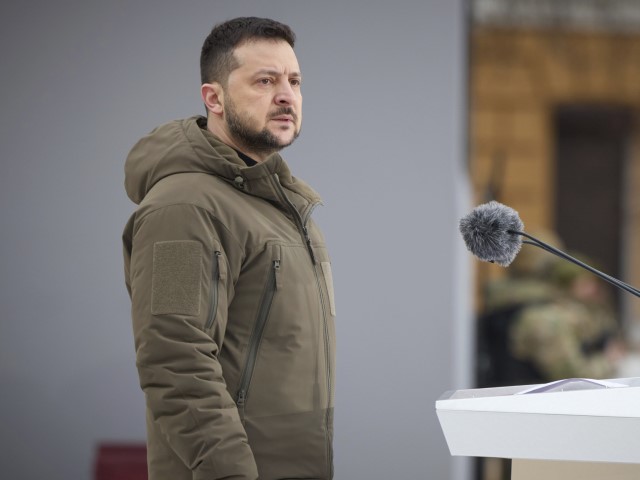
Ukrainian President Volodymyr Zelenskyy attends a commemorative event on the occasion of the Russia Ukraine war one year anniversary in Kyiv, Ukraine, Friday, February 24, 2023. (Ukrainian Presidential Press Office via AP)
The broadly held view in the West, difficult to verify conclusively with the secretive and duplicitous Russian government, is that Putin anticipated a lightning war with a swift victory, perhaps even something like a decapitation strike that would eliminate Ukrainian President Volodymyr Zelensky and his top commanders, leaving a shattered Ukraine to quickly capitulate.
This strategy was quickly undermined by unexpectedly stiff Ukrainian resistance — and unexpectedly poor Russian military performance — including logistical nightmares, equipment failures, and the belated discovery that Russian armor and artillery was highly vulnerable to Ukraine’s inventory of cheap and highly effective Turkish drones.
Russia stepped up its drone game, with help from first Iran and now possibly China. Germany’s Der Spiegel reported on Friday that Chinese drone maker Xian Bingo Intelligent Aviation Technology is in talks with Moscow to sell a hundred of its prototype ZT-180 unmanned aerial vehicle (UAV), an attack drone that can carry warheads weighing up to 50 kilograms, making its strike power comparable to the Iranian Shaheed-136 models Russia is already using to attack Ukrainian civilian targets. Russia reportedly hopes to create a factory for Xian Bingo that can crank out a hundred more of the drones every month.
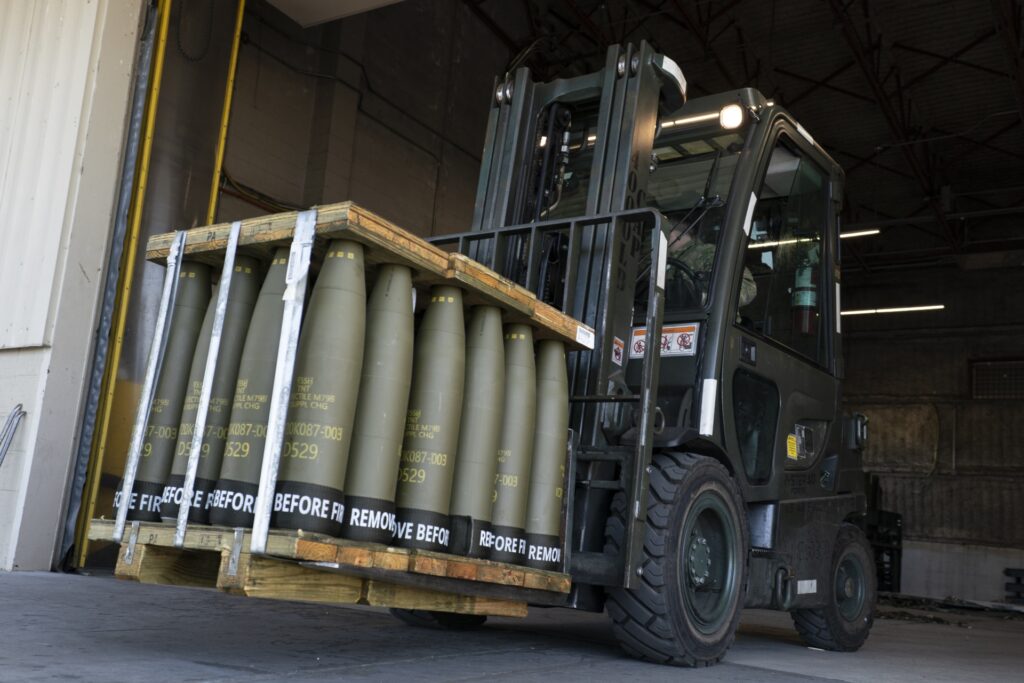
Airmen with the 436th Aerial Port Squadron use a forklift to move 155 mm shells ultimately bound for Ukraine, April 29, 2022, at Dover Air Force Base, Delaware. (AP Photo/Alex Brandon)
Chinese government officials disputed the Der Spiegel report, which would represent a significant escalation in the international diplomatic crisis surrounding the Russian invasion. The notion of Russia buying drones from China fits with both China’s growing insistence that its junior partner Russia is somehow a victim in the war it started, and that only by recognizing the legitimacy of Putin’s grievances can the rest of the world bring peace to Ukraine.
It also fits with Russia’s desire to avoid any more heavy casualties. Accurate information about military losses is very difficult to extract from the Russian war machine, but the best guess of outside observers is that almost 200,000 Russian troops have been killed and wounded, with casualties spiking as conscripts and prisoners are dropped into the fray as cannon fodder.
“Russia analysts say that the loss of life is unlikely to be a deterrent to Mr. Putin’s war aims.” https://t.co/Eeo2qZaI7R
— Chris Megerian (@ChrisMegerian) February 21, 2023
Conventional wisdom holds that Putin can sustain much higher casualties before he needs to worry about his grip on power, and the dictator himself is fond of reminding his people that eight million Russians died to defeat Nazi Germany, so they should have no problem with losing a few hundred thousand of their sons to defeat “Nazi” Ukraine.
Still, Putin seems hesitant to pull the trigger on the kind of conscription and mobilization plan that could throw overwhelming manpower against the Ukrainians. When he seems to be getting serious about conscription, a large number of Russians suddenly dust off their passports and go on foreign vacations.
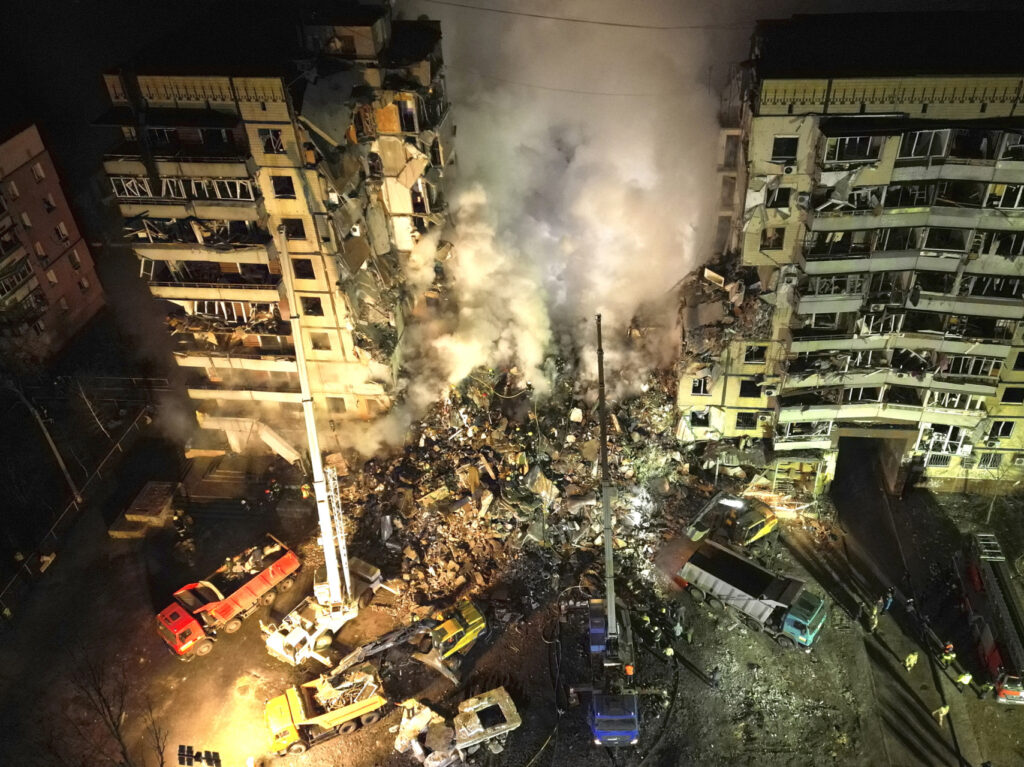
Emergency workers clear the rubble after a Russian rocket hit a multistory building leaving many people under debris in the southeastern city of Dnipro, Ukraine, Saturday, January 14, 2023. (AP Photo/Evgeniy Maloletka)
It is not quite accurate to say that Ukraine is an absolute quagmire for the Russians. They have made slow progress on a few fronts, grabbing about 11 percent of Ukraine’s territory to add to the ersatz “independent republics” Putin declared by decree in eastern Ukraine at the outset of the war, plus the Crimean peninsula, which Russia annexed in 2014.
Ukraine’s military losses are heavy as well — perhaps proportionally greater than Russia’s, given that Ukraine is much smaller — and over 8,000 Ukrainian civilians are believed to have been killed as well, many of them quite deliberately. Tens of thousands of Ukrainians have been displaced. Russia’s ability to inflict morale-threatening pain on Ukraine remains formidable.
As long as Russians prefer to aim their frustration killing Ukrainians, not rioting against their government for sending them to death in meat waves, this will continue, unfortunately. Another one from me today. https://t.co/F8n7cjm60q
— Nika Melkozerova (@NikaMelkozerova) January 7, 2023
Russia might be having an unexpectedly hard time delivering a knockout punch or capturing vital strategic objectives, but it has the size advantage and utter ruthlessness needed to win a long war of attrition.
The U.N. Human Rights Commission said on Tuesday that the civilian death toll in Ukraine is probably much higher than the confirmed count, especially in Russian-controlled areas where oversight is extremely difficult, but disturbing reports of torture, executions, and sexual abuse have emerged.
Harvard University's @GrahamTAllison and team have put together a report card comparing some of the key indicators re: Russia's war in Ukraine so far.
Graph below and article in @ForeignPolicy here: https://t.co/IY67rhwL1n pic.twitter.com/HGuVaIZOsi— Ravi Agrawal (@RaviReports) February 23, 2023
The U.N. said Ukrainian attacks have caused civilian casualties as well, including about 200 in Russian Federation territory and Russian-occupied Crimea.
“My colleagues interviewed a former prisoner of war, and he was from Mariupol and he was forced in Mariupol to collect the bodies on the city streets. He told us that Russian soldiers were expected to meet the daily quota of one truck of corpses per day. And that is, as he said, in Mariupol meeting with that quota was not a problem at all,” said Matilda Bogner, leader of the U.N. human rights mission to Ukraine.
“The toll on civilians is unbearable. Amid electricity and water shortages during the cold winter months, nearly 18 million people are in dire need of humanitarian assistance. Some 14 million people have been displaced from their homes,” said U.N. High Commissioner for Human Rights Volker Turk.
“Every day that violations of international human rights and humanitarian law continue, it becomes harder and harder to find a way forward through mounting suffering and destruction, towards peace,” Turk said.
Full horror of #Mariupol civilian death toll now coming to light @UNHumanRightsUA @UNHumanRights https://t.co/dhrIiz8NcI
— UN News (@UN_News_Centre) February 21, 2023
Putin is not even terribly close to seizing his new “republics” of Donetsk and Luhansk, an objective that many analysts see as his minimum threshold for declaring a limited victory and negotiating a ceasefire.
The much-touted offensive Russia worked up for the first anniversary of the conflict has not amounted to much as of yet, and the Ukrainian military said on Thursday it has already launched a counteroffensive to push Russia back from Kharkiv, the second-largest city in Ukraine.
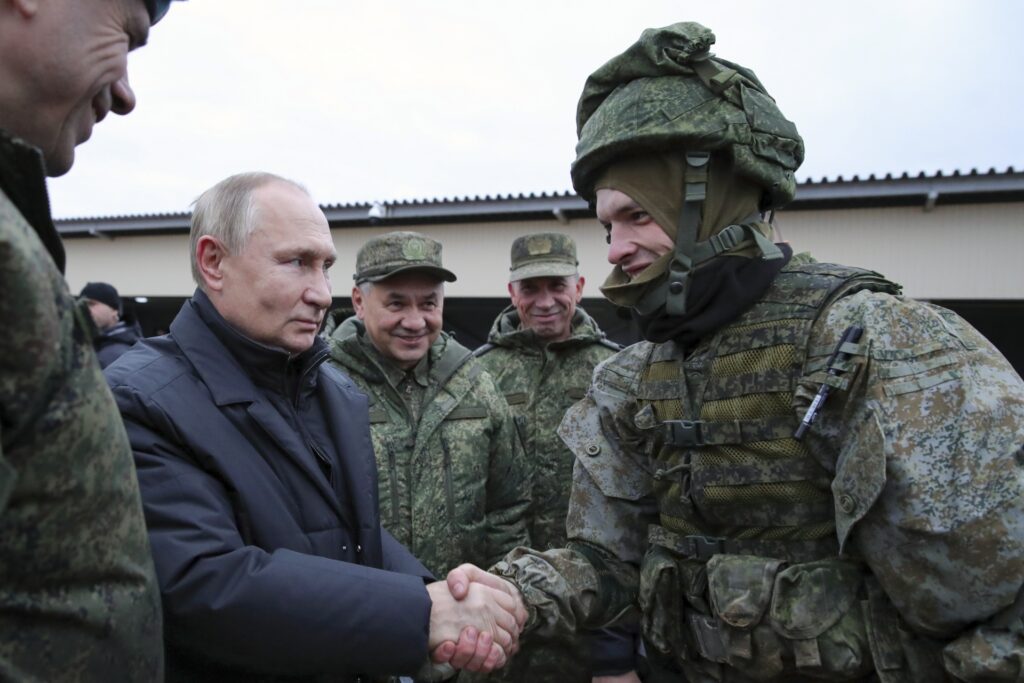
Russian President Vladimir Putin shakes hands with a soldier as he visits a military training centre of the Western Military District for mobilised reservists as Russian Defense Minister Sergei Shoigu, center, smiles in Ryazan Region, Russia, Thursday, October 20, 2022. (Mikhail Klimentyev, Sputnik, Kremlin Pool Photo via AP)
Zelensky and some of his top advisors said this week that the war could boil down to a long, grueling struggle for the Donbas region, and possibly a land corridor that would connect Donbas to Crimea, but Russia no longer has any realistic military objectives beyond that.
Maj. Gen. Kyrlyo Budanov was more optimistic, predicting that Russia will hit a “breaking point” in late August and throw in the towel by the end of 2023, surrendering not only Donbas but Crimea in the process.
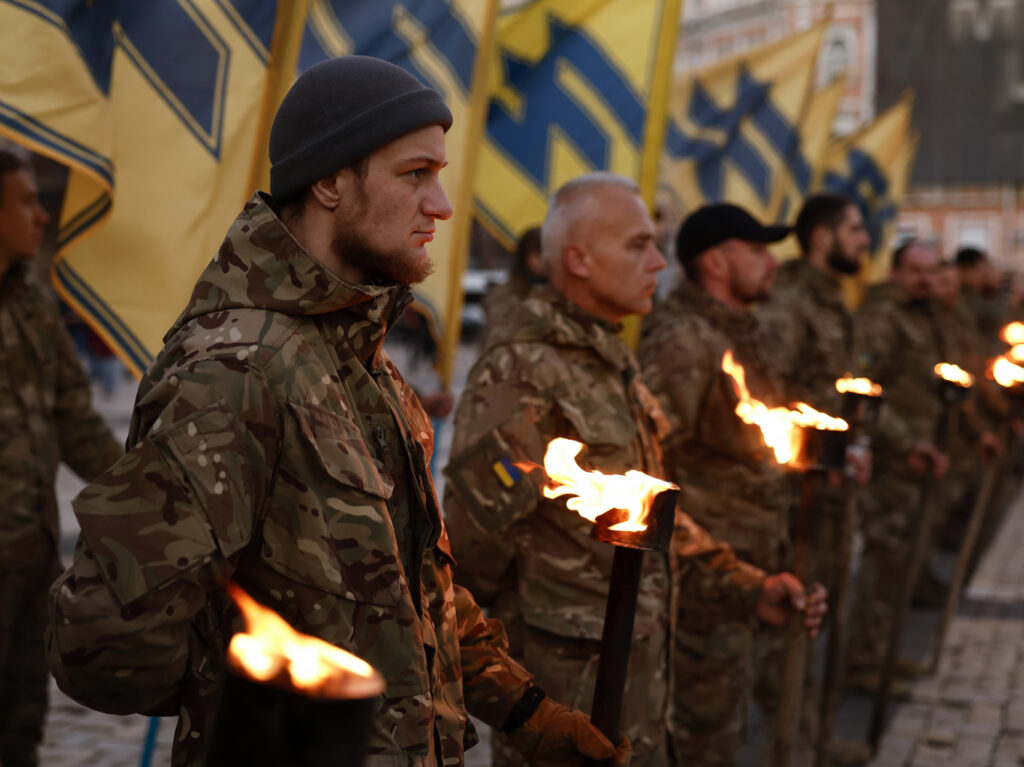
Soldiers of the Azov regiment attend a memorial event called “Mystery” in Urzuf in St Sophia Square on November 13, 2022, in Kyiv, Ukraine. (Jeff J Mitchell/Getty Images)
If the deadlock finally breaks, it might be the shipments of advanced Western armor that finally makes one of Ukraine’s counteroffensives into a decisive victory. Poland said its first shipment of four top-shelf German Leopard 2A4 battle tanks would arrive in Ukraine on Friday as a symbolic gesture on the anniversary of the invasion, with 14 more German tanks and 60 updated Soviet-era tanks coming over the next few days.
The Biden administration characteristically bungled its promise to supply 31 M1 Abrams tanks to Ukraine, admitting on Thursday that it could take two years instead of the “matter of weeks” originally promised. The administration promised that $2 billion in rockets, drones, and ammo would arrive much sooner.
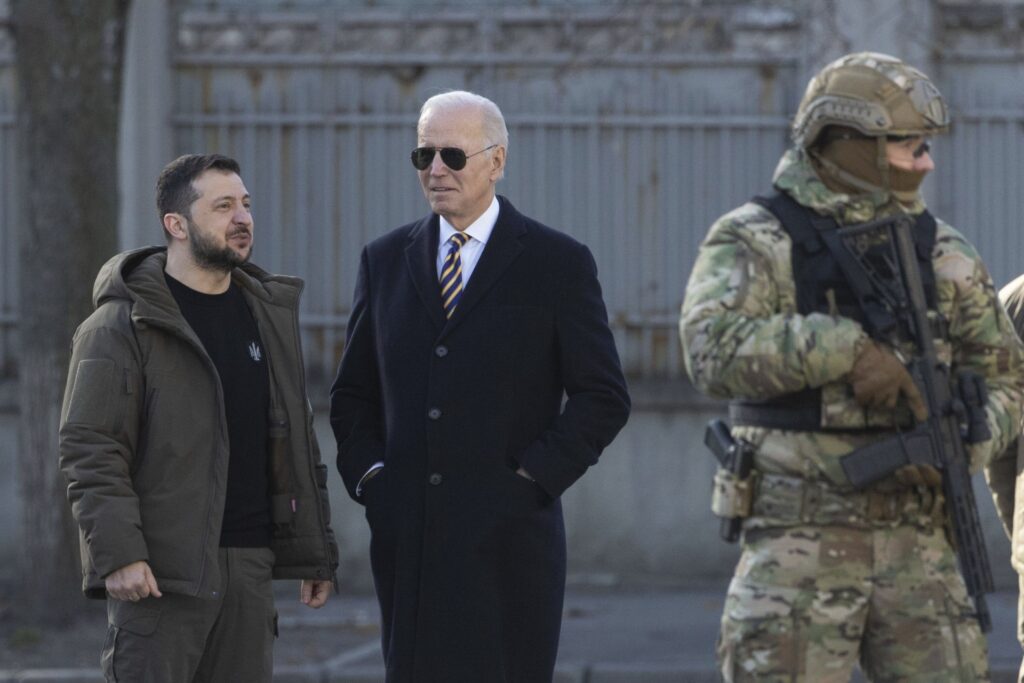
President Joe Biden, center, and Ukrainian President Volodymyr Zelenskyy talk during an unannounced visit in Kyiv, Ukraine, Monday, February 20, 2023. (Ukrainian Presidential Press Office via AP)
The White House promised more sanctions against Russia as well, but the sanctions strategy has been no more able to deliver a solid punch against Putin than he could land a knockout blow on Kyiv. A Gallup survey at the end of 2022 found Russians more confident than ever of their economic strength and notched the highest level of satisfaction with the Russian standard of living in Gallup’s polling history.
“The number of Russians reporting that their economic conditions were improving grew to 44% from 40%, while the number who said their economic prospects were declining plummeted to 29% from 50%,” Gallup noted, with due allowance for the possibility that some respondents feared reprisals from the Putin regime if they were not sufficiently optimistic.
Early projections guessed the sanctions regime would cut Russia’s economy down by at least ten percent by the first anniversary of the invasion. Instead, the Russian economy contracted by about two percent and may actually grow in 2023.
Survey Shows Russians Increasingly Confident About Economic Futurehttps://t.co/N9C8vIHyiu
— Voice of America (@VOANews) February 24, 2023
The Russian financial system has proven resilient in the face of sanctions, while businessmen had little trouble finding new customers and vendors in countries such as China and India. If anything, Russia is making more money than ever by selling oil.
Bloomberg News on Friday dourly described President Joe Biden’s much-hyped “shock and awe” sanctions as more of a “distraction” for Putin. Some real economic damage was inflicted, but not nearly enough to “change Russian decision-making.”
Some say sanctions never work. That’s not true. Others say they work all the time and we just need more of them. That’s also not true. They’ve had a significant impact on the Russian economy but have so far failed to stop the war. Our story on year one: https://t.co/nh0nHkZxxE
— Daniel Flatley (@DanielPFlatley) February 24, 2023
In fact, the economic war has become an uncomfortable parallel of the stalemate on the ground, a grim “war of attrition” in the estimation of Cornell professor Nicholas Mulder. The West is arguably bleeding money faster than Russia, but it began with more to lose, just as Russia’s capacity to absorb military casualties is higher than Ukraine’s.
The next steps to ratchet up sanctions even tighter will necessarily involve pressuring Russia’s suppliers and oil customers to stop doing business with Moscow — and that could easily drive them right into the waiting arms of Beijing, which is very eager to break the power of Western sanctions once and for all.
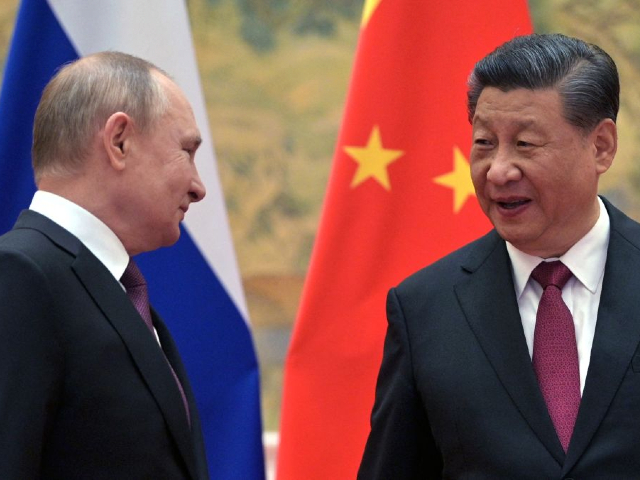
Russian President Vladimir Putin (L) and Chinese President Xi Jinping arrive to pose for a photograph during their meeting in Beijing, on February 4, 2022. (ALEXEI DRUZHININ/Sputnik/AFP via Getty Images)
The $300 billion or so in net economic damage inflicted on Russia by sanctions must be measured against not only the damage those sanctions have also inflicted on Western economies, but the staggering amount of financial aid poured into Ukraine by debt-loaded governments such as the United States.
Ukraine is now the first European country to become the top recipient of American foreign aid since the rebuilding of the continent after World War II. The U.S. has kicked in over $75 billion so far, with billions more on the table. The combined European Union has contributed about half as much, bringing total worldwide support for Ukraine up to about $135 billion.
Russia’s entire military budget for 2023 was about $84 billion. While it is some comfort for them to see Moscow taking on unprecedented levels of debt to sustain that spending, the U.S. and Europe are coming dangerously close to their credit card limits as well. American voters on the invasion anniversary are roughly evenly divided between unlimited support for Ukraine and demanding an “exit strategy,” as the media was once fond of saying. Support for unlimited investment is unlikely to increase if another year of expensive stalemate leads up to the 2024 U.S. presidential election.
6⃣ Biden officials: "Our sanctions will make it harder for the Kremlin to use the remaining resources Russia can access to pay for the weapons they need."
Reality: Russia's military budget is set to INCREASE by 40% in 2023 compared to the original budget.https://t.co/NMK6oiqRX3
— Gabriel Noronha (@GLNoronha) February 22, 2023
On the grim first anniversary of the Russian invasion, no one even seems to know what “victory” or “peace” would look like. Joint Chiefs Chairman Gen. Mark Milley summed the quagmire up on Thursday by saying neither the Russians nor Ukrainians are within a year of realizing their strategic objectives, and it might not be possible for either side to win – which means neither will come close enough to losing to sue for peace.
“What is achievable, I think, is significant liberation of Ukrainian territory, and maybe, if we’re lucky, touch wood, the diplomats will enter the fray here and they’ll get to a negotiating table at some point,” Milley said.
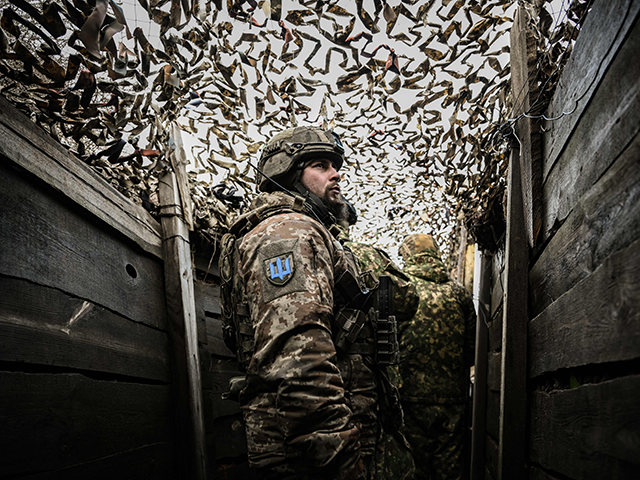
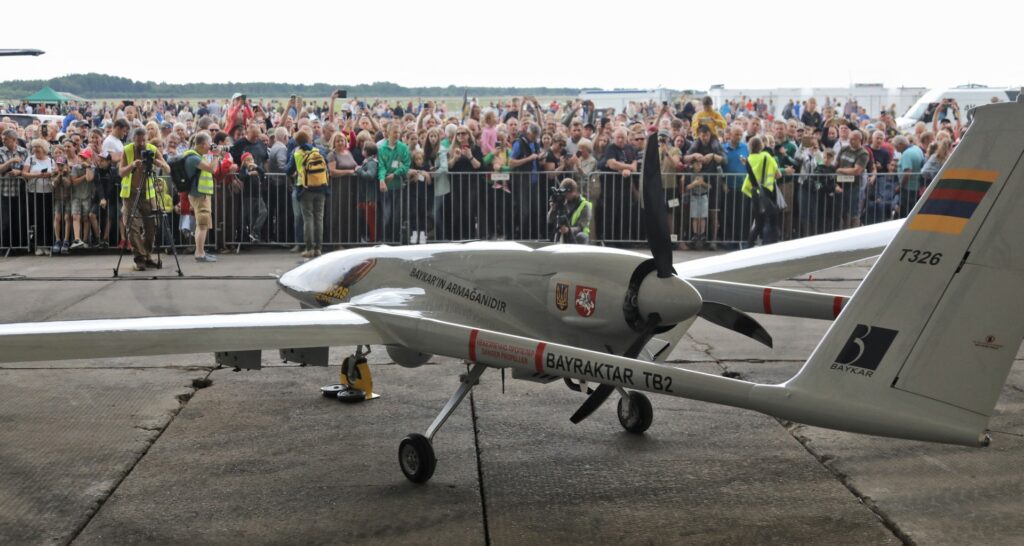
COMMENTS
Please let us know if you're having issues with commenting.